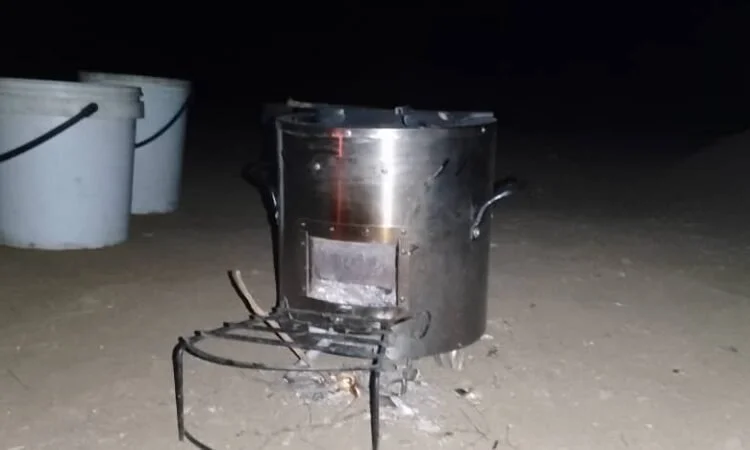Traditional stoves can help stop deforestation in Zimbabwe
As first appeared in Community Podium News in Zimbabwe, here. Written by Calvin Manika.
February 16 2023
Rural villages report decline in illegal logging for cooking and heating since adopting the use of the energy-efficient stoves
The stoves have been used in the southern African nation since the 1980s. Image by Calvin Manika.
An energy efficient clay-made stove that’s been used in Zimbabwe since for decades has been potentially identified as an environmentally friendly panacea to curtailing deforestation in the southern African nation.
Twigs are sufficient to sustain the stoves’s energy for a considerably long period of time, thus saving trees. Unlike the traditional open fire, the “tsotso” stove has a chimney.
Sinikiwe Ngwenya of Kuthuleni Village, in Matobo near Bulawayo, says the Tsotso stove has changed her life for the better. In the absence of her grandchildren she can prepare a meal that would still be served warm when her grandchildren arrive from school. Before investing in the Tsotso stove, she had to wait for them to come back from school and start cooking otherwise they would have had to make do with cold meals.
“Things have changed. We no longer need to cut down trees for large logs because the stove is energy efficient and environmentally beneficial. To cook and bake anything I want for the family and business, the stove can easily be fueled by small twigs,” said Ngwenya.
Tsotso is a Shona word which means “small logs or twigs,” obtained from tree branches.
Forests are disappearing as a result of deforestation and illegal timber logging. Consequently, Zimbabwe is slowly losing its biodiversity and a wide range of species. The forestry commission of Zimbabwe estimates that about 300,000 hectares of forests are lost to deforestation and veld fires annually.
“We have seen a change to our environment in the past four years in my village. I cannot remember the last time I saw people cutting down whole trees. Just a bundle of twigs can be used to prepare six to ten meals,” said Anna Dube, another villager.
The Tsotso stove burns wood efficiently and is composed of clay or sheet metal. In the 1980s, David Hancock created it in Zimbabwe. It is currently the only commercially viable wood burning stove produced in the country, having sold more than 30,000 units.
The Tsotso stove preheats secondary air and only one control for both. The fire grate is composed of mild steel and has a detachable wire bottom grid. Vermiculite was placed inside the stove body to promote stability and the heating of the secondary air. A frying pan can be set on the cut-out in the top side wall, which also offers some protection from the wind. An efficiency of roughly 21%, much higher than a typical fire, was recorded by David Hancock.
When the stove was made, it was intended to save people from the labour involved in firewood searching and for convenience in cooking. Additionally, the Tsotso stove has helped efforts to restore and protect forests.
“The use of Tsotso helps us to easily identify firewood poachers. Locally, we know we have these stoves and there is no reason to cut down trees unless on rare occasions when one is building a kraal or clearing farming land. If we see anybody randomly cutting down trees we report to the forest commission,” said Anna Mutale, from Binga area.
Heaps of firewood are found in various spots along the Bulawayo – Victoria Falls Road, and the vendors rarely appear next to the heaps unless convinced that a potential buyer is not a law enforcement agent. With most of the villagers using Tsotso stoves, firewood poachers have been exposed and villagers are helping the authorities to flash them out.
The Tsotso stoves cost around $40 (£33.84) and need only a few twigs to make a fire for cooking or heating. It is estimated that the stove halves the amount of wood needed, which also helps in the fight against deforestation. The current rate at which trees are being felled is unsustainable, especially in rural areas where trees like the Musasa are cut down on a daily basis.
In response to the needs of many rural areas where people cannot afford to buy the stoves, some donors have distributed the stoves free of charge. Some of the stoves in rural areas, especially those made from clay, are produced by the villagers after undergoing training.
In other areas, notably Chipinge and Chimanimani, the stoves in different shapes and sizes were introduced by the Ministry of Health and Childcare (MoHCC) in partnership with UNICEF, under the Sustainable Energy for Health Facilities and Surrounding Communities Programme (SE4HF). With funding support from the Government of Sweden, SE4HF seeks to provide a more sustainable solution to protecting the environment while encouraging financial freedom for women.
Villagers around Matabeleland South and North expressed their confidence in Tsotso stoves citing that the protection of forests was beneficial to their nutritional needs as the preservation of trees has meant a bigger harvest of caterpillar worms (amacimbi).
“We need to pass this (of using Tsotso stoves) culture to the coming generations so that our environment and forests remain green and protected. We are known in Binga to be rich in culture and have beautiful tourist sites,” said Mutale.
In view of constant power cuts in urban areas, which are causing rapid deforestation in areas around towns and cities, environmentalists and foresters contend that the Tsotso stove can be the solution in towns.
“Although the stove has not been very popular over the years, frequent power cuts and high paraffin and gas prices are making people think again. The Tsotso stove is the solution in terms of cost and the preservation of forests which are critical for our ecosystem and habitat to a variety of wildlife,” said Pauline Chakwesha, an environmentalist.
In addition to deforestation and biodiversity loss, firewood contributes significantly to air pollution. According to statistics from the World Health Organization (WHO) for 2017, household air pollution is to blame for 534,000 of the world’s annual deaths of children under the age of five. Lung cancer, chronic respiratory disease, and pneumonia are all brought on by exposure to smoke from cookstoves and open fires, which is thought to be the cause of 1.6 million annual deaths globally.
“The materials to build the stoves are free and readily available locally. The stove saves time and trees. Because the firewood saving stoves use less wood and emit less smoke, this reduces the amount of greenhouse gases released in the air,” said Chakwesha.
Another forest expert said there is a difference between the areas where communities have adopted the tsotso for use compared to those still using wood for fire. Evans Nkomo, a forester, says the tsotso is a great success story in communities that have embraced it.
“It gives us hope for sustainability and posterity. The other areas must also join the tsotso stove bandwagon because forests are disappearing, at an alarming rate,” said Nkomo.
This article is reproduced here as part of the African Conservation Journalism Programme, funded in Angola, Botswana, Mozambique, and Zimbabwe by USAID’s VukaNow: Activity. Implemented by the international conservation organisation Space for Giants, it aims to expand the reach of conservation and environmental journalism in Africa, and bring more African voices into the international conservation debate. Written articles from the Mozambican and Angolan cohorts are translated from Portuguese. Broadcast stories remain in the original language.

